OLDSMOBILE SILHOUETTE 1997 Owners Manual
Manufacturer: OLDSMOBILE, Model Year: 1997, Model line: SILHOUETTE, Model: OLDSMOBILE SILHOUETTE 1997Pages: 436, PDF Size: 21.87 MB
Page 121 of 436
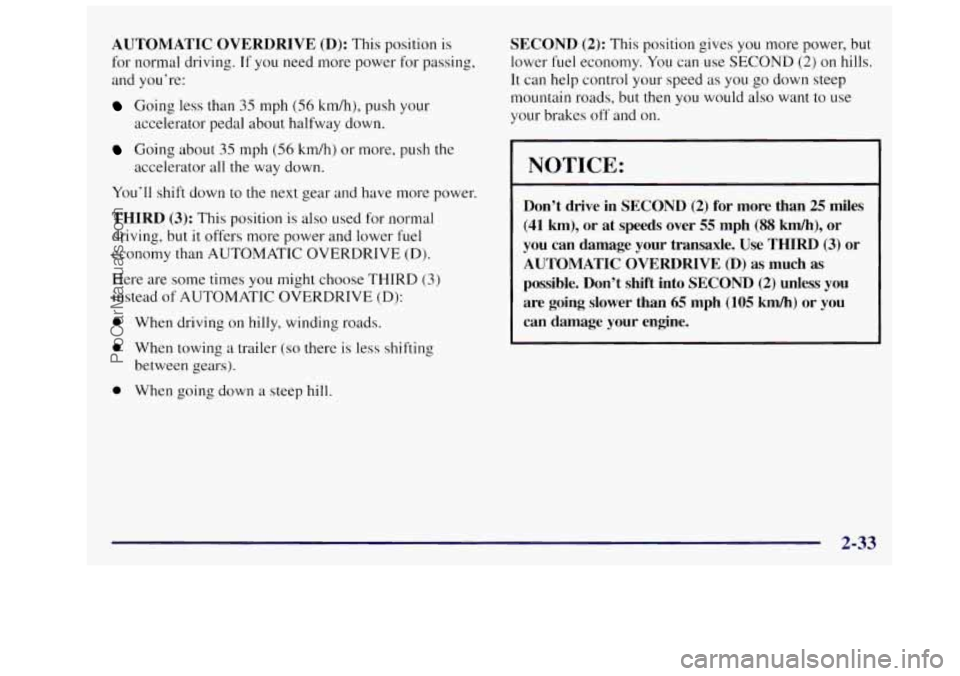
AUTOMATIC OVERDRIVE (D): This position is
for normal driving.
If you need more power for passing,
and you’re:
Going less than 35 mph (56 kdh), push your
Going about 35 mph (56 km/h) or more, push the
accelerator
pedal about halfway down.
accelerator
all the way down.
You’ll shift down to the
next gear and have more power.
THIRD (3): This position is also used for normal
driving, but
it offers more power and lower fuel
economy than AUTOMATIC OVERDRIVE (D).
Here are some times
you might choose THIRD (3)
instead of AUTOMATIC OVERDRIVE (D):
0 When driving on hilly, winding roads.
0 When towing a trailer (so there is less shifting
between gears).
0 When going down a steep hill.
SECOND (2): This position gives you more power, but
lower fuel economy. You can use SECOND
(2) on hills.
It can help control your speed as you go down steep
mountain roads, but then you would also want
to use
your brakes off and on.
NOTICE:
Don’t drive in SECOND (2) for more than 25 miles
(41 km), or at speeds over 55 mph (88 km/h), or
you can damage your transaxle. Use
THIRD (3) or
AUTOMATIC OVERDRIVE
(D) as much as
possible. Don’t shift into SECOND (2) unless you
are going slower than
65 mph (105 km/h) or you
can damage your engine.
2-33
ProCarManuals.com
Page 122 of 436
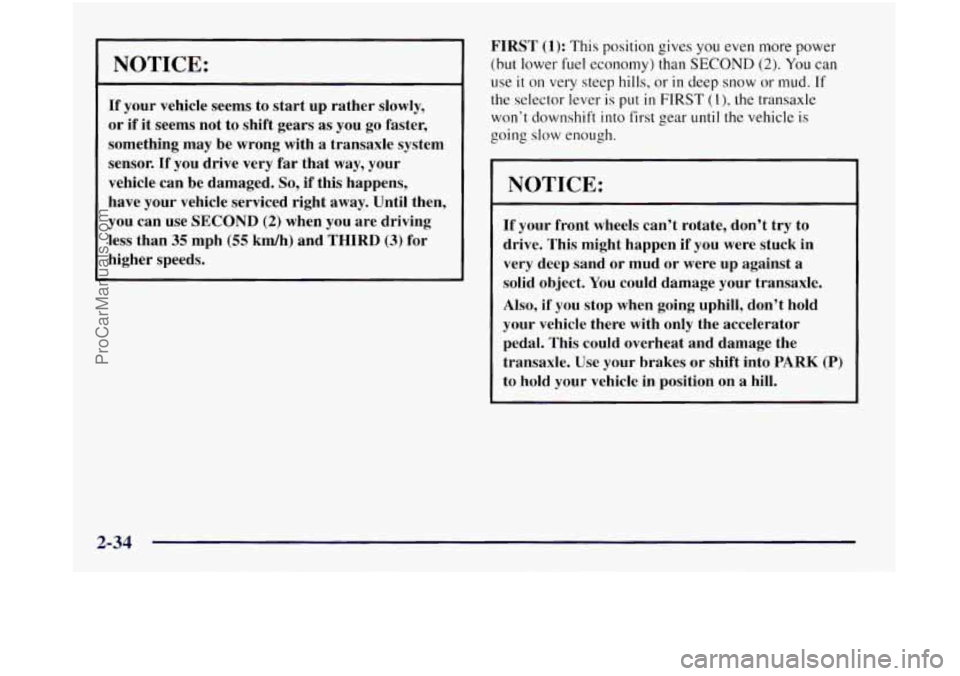
NOTICE:
If your vehicle seems to start up rather slowly,
or if it seems not to shift gears as you go faster,
something may be wrong with
a transaxle system
sensor.
If you drive very far that way, your
vehicle can be damaged.
So, if this happens,
have your vehicle serviced right
away. Until then,
you can use SECOND
(2) when you are driving
less than
35 mph (55 kmh) and THIRD (3) for
higher speeds.
FIRST (1): This position gives you even more power
(but lower fuel economy) than
SECOND (2). You can
use it on very steep hills, or in deep snow or mud. If
the selector lever is put in FIRST (I), the transaxle
won’t downshift into first gear
until the vehicle is
going
slow enough.
NOTICE:
If your front wheels can’t rotate, don’t try to
drive. This might happen if you were stuck in
very deep sand or mud or were up against
a
solid object. You could damage your transaxle.
Also, if you stop when going uphill, don’t hold
your vehicle there with only the accelerator
pedal. This could overheat and damage the
transaxle.
Use your brakes or shift into PARK (P)
to hold your vehicle in position on a hill.
2-34
ProCarManuals.com
Page 123 of 436
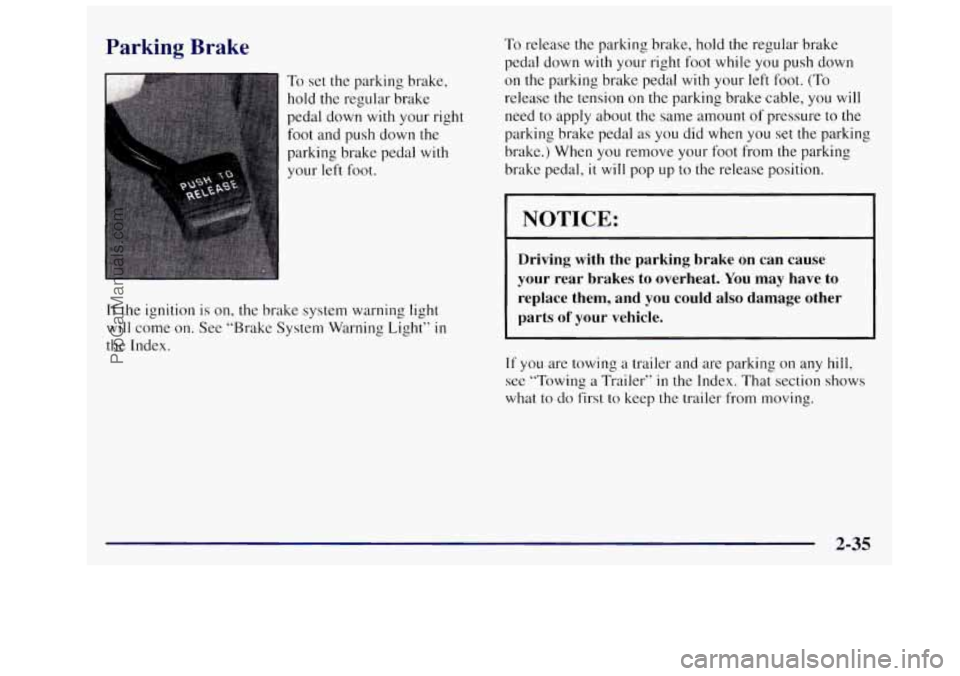
Parking Brake
To set the parking brake,
hold the regular brake
pedal down
with your right
foot and push down
the
parking brake pedal with
your left foot.
If the ignition is on, the brake system warning light
will come on. See “Brake System Warning Light” in
the Index.
To release the parking brake, hold the regular brake
pedal down
with your right foot while you push down
on the parking brake pedal with your left foot. (To
release the tension on the parking brake cable, you will
need to apply about the same amount of pressure to the
parking brake pedal as you did when you set the parking
brake.) When you remove your foot from the parking
brake pedal,
it will pop up to the release position.
I NOTICE:
Driving with the parking brake on can cause
your rear brakes to overheat. You
may have to
replace them, and you could also damage other
parts
of your vehicle.
If you are towing a trailer and are parking on any hill,
see “Towing a Trailer” in the Index. That section shows
what to
do first to keep the trailer from moving.
2-35
ProCarManuals.com
Page 124 of 436
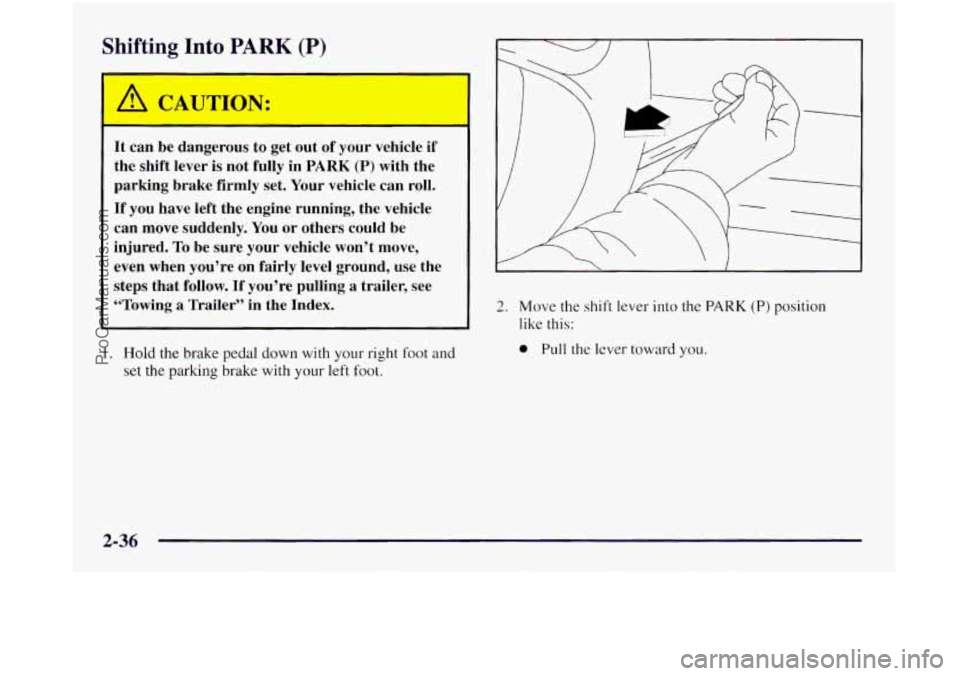
Shifting Into PARK (P)
It can be dangerous to get out of your vehicle if
the shift lever is not fully in
PARK (P) with the
parking brake firmly set. Your vehicle can roll.
If you have left the engine running, the vehicle
can move suddenly. You
or others could be
injured.
To be sure your vehicle won’t move,
even when you’re on fairly level ground,
use the
steps that follow.
If you’re pulling a trailer, see
“Towing
a Trailer” in the Index.
1. Hold the brake pedal down with your right foot and
set the parking brake with your left foot.
II
I
2. Move the shift lever into the PARK (P) position
like this:
0 Pull the lever toward you.
2-36
ProCarManuals.com
Page 125 of 436
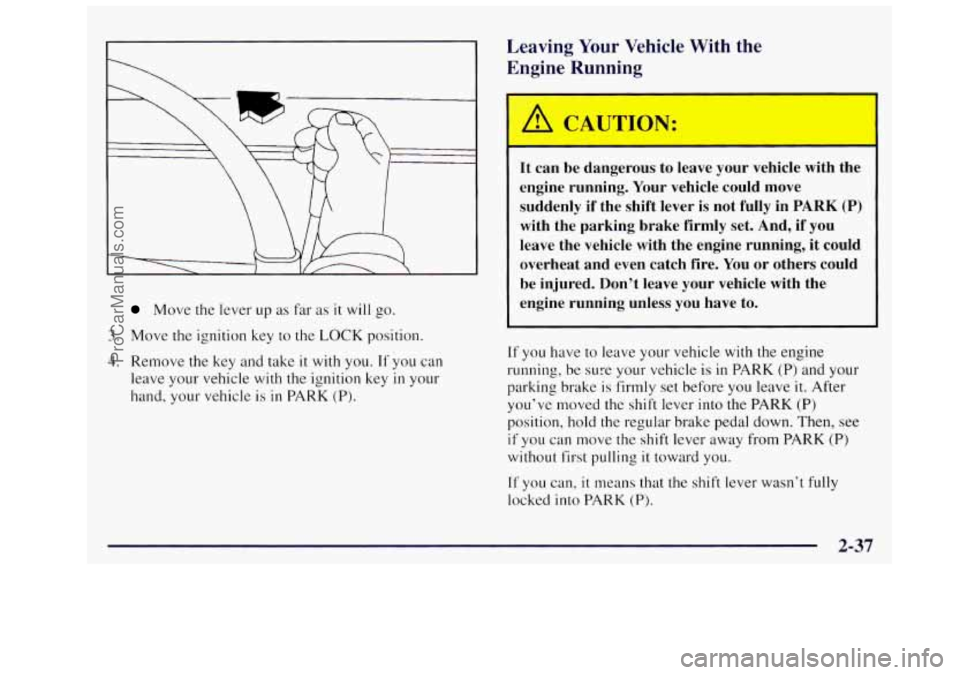
Move the lever up as far as it will go.
3. Move the ignition key to the LOCK position.
4. Remove the key and take it with you. If you can
leave your vehicle with the ignition key
in your
hand, your vehicle is in PARK
(P).
Leaving Your Vehicle With the
Engine Running
It can be dangerous to leave your vehicle with the
engine running. Your vehicle could move
suddenly if the shift lever
is not fully in PARK (P)
with the parking brake firmly set. And, if you
leave the vehicle with the engine running, it could
overheat and even catch fire. You or others could
be injured. Don’t leave your vehicle with the
engine running unless you have to.
If you have to leave your vehicle with the engine
running, be sure your vehicle is in PARK
(P) and your
parking brake is
firmly set before you leave it. After
you’ve moved the shift lever into the PARK
(P)
position, hold the regular brake pedal down. Then, see
if you can move the shift lever away from PARK (P)
without first pulling it toward you.
If you can, it means that the shift lever wasn’t fully
locked into PARK
(P).
ProCarManuals.com
Page 126 of 436
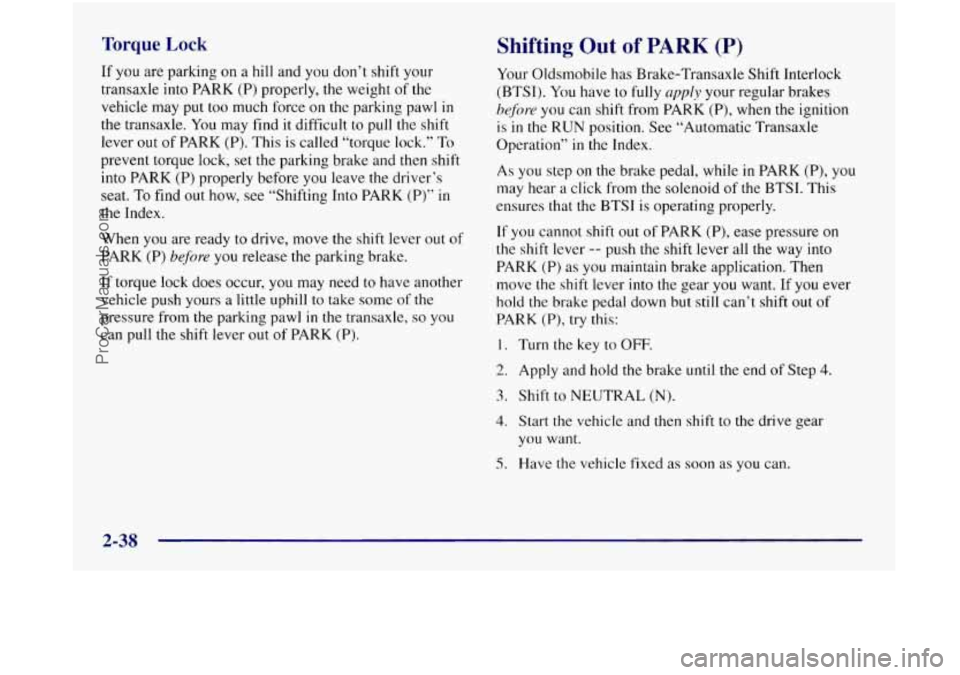
Torque Lock
If you are parking on a hill and you don’t shift your
transaxle into PARK
(P) properly, the weight of the
vehicle may put
too much force on the parking pawl in
the transaxle. You may find it difficult to pull the shift
lever out of PARK (P). This is called “torque lock.” To
prevent torque lock, set the parking brake and then shift
into PARK (P) properly before
you leave the driver’s
seat.
To find out how, see “Shifting Into PARK (P)” in
the Index.
When you are ready to drive, move the shift lever out of
PARK (P)
before you release the parking brake.
If torque lock does occur,
you may need to have another
vehicle push yours a little uphill
to take some of the
pressure from the parking pawl in the transaxle,
so you
can pull the shift lever out of PARK
(P).
Shifting Out of PARK (P)
Your Oldsmobile has Brake-Transaxle Shift Interlock
(BTSI). You have to fully
apply your regular brakes
before you can shift from PARK (P), when the ignition
is
in the RUN position. See “Automatic Transaxle
Operation”
in the Index.
As you step on the brake pedal, while in PARK (P), you
may hear a click from the solenoid of the BTSI. This
ensures that the
BTSI is operating properly.
If you cannot shift out of PARK (P), ease pressure on
the shift lever
-- push the shift lever all the way into
PARK (P)
as you maintain brake application. Then
move the shift lever into the gear you want. If
you ever
hold
the brake pedal down but still can’t shift out of
PARK
(P), try this:
1. Turn the key to OFF.
2. Apply and hold the brake until the end of Step 4.
3. Shift to NEUTRAL (N).
4. Start the vehicle and then shift to the drive gear
you want.
5. Have the vehicle fixed as soon as you can.
2-38
ProCarManuals.com
Page 127 of 436
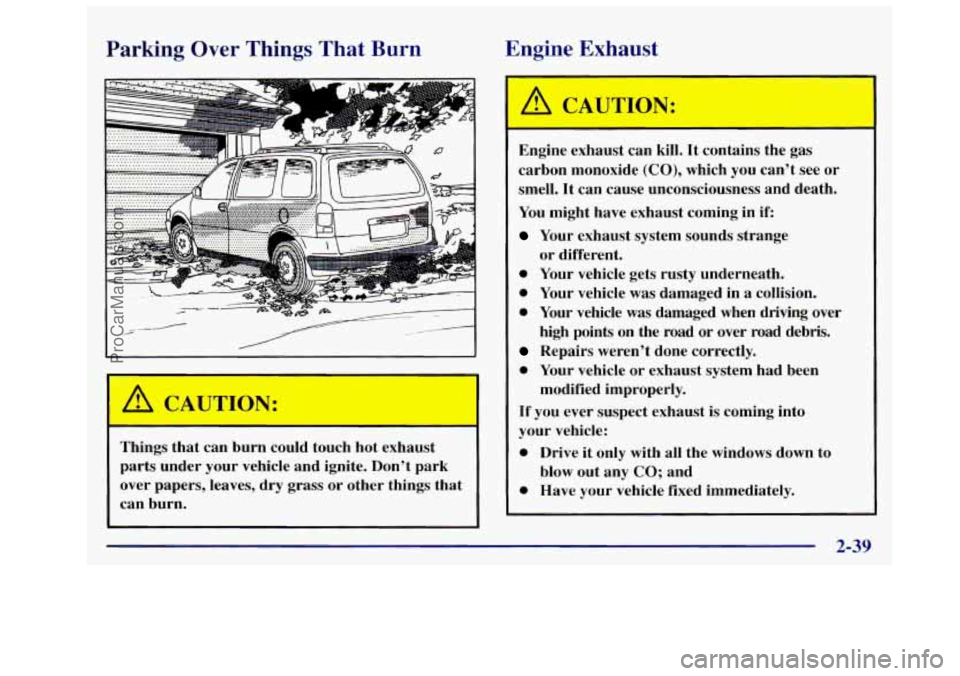
Parking Over Things That Burn Engine
Exhaust
I
A CAU JN: I
Things that can burn could touch hot exhaust
parts under your vehicle and ignite. Don't park
over papers, leaves,
dry grass or other things that
can burn. Engine exhaust can
kill. It contains the gas
carbon monoxide
(CO), which you can't see or
smell. It can cause unconsciousness and death.
You might have exhaust coming in if:
Your exhaust system sounds strange
0 Your vehicle gets rusty underneath.
0 Your vehicle was damaged in a collision.
0 Your vehicle was damaged when driving over
high points on the road
or over road debris.
Repairs weren't done correctly.
0 Your vehicle or exhaust system had been
If you ever suspect exhaust is coming into
your vehicle:
0 Drive it only with all the windows down to
0 Have your vehicle fixed immediately.
or
different.
modified improperly. blow out any
CO; and
ProCarManuals.com
Page 128 of 436
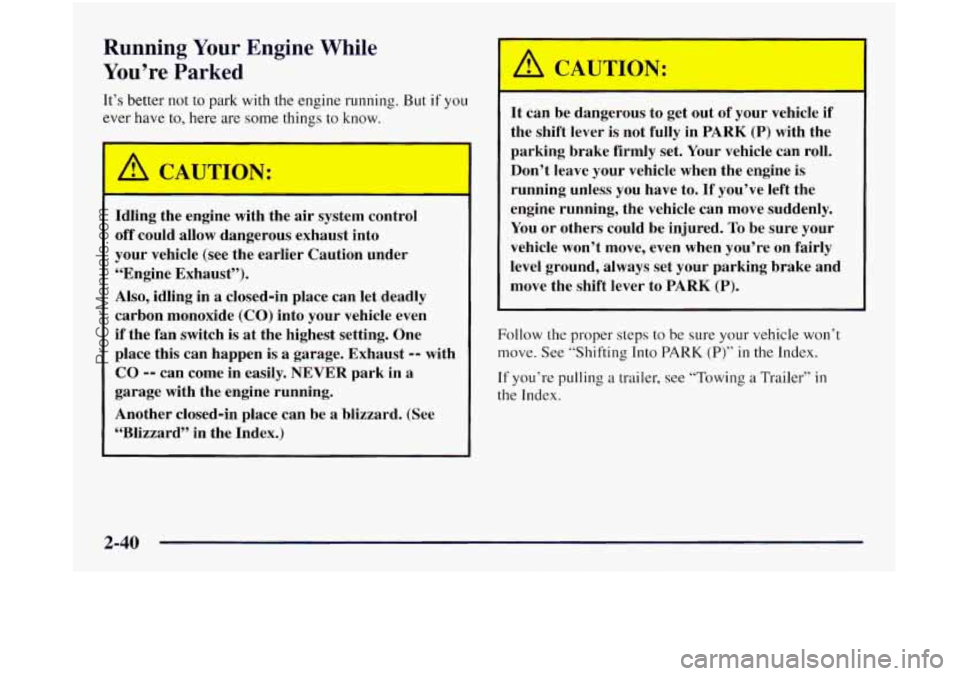
Running Your Engine While
You’re Parked
It’s better not to park with the engine running. But if you
3ver have to, here are some things to know.
A CAUTION:
Idling the engine with the air system control
off could allow dangerous exhaust into
your vehicle (see the earlier Caution under
“Engine Exhaust”).
Also, idling in a closed-in place can let deadly
carbon monoxide
(CO) into your vehicle even
if the fan switch is at the highest setting. One
place this can happen
is a garage. Exhaust -- with
CO -- can come in easily. NEVER park in a
garage with the engine running.
Another closed-in place can be a blizzard. (See
“Blizzard” in the Index.) It
can be dangerous
to get out of your vehicle if
the shift lever is not fully in PARK (P) with the
parking brake firmly set. Your vehicle can
roll.
Don’t leave your vehicle when the engine is
running unless you have to.
If you’ve left the
engine running, the vehicle can move suddenly.
You or others could be injured.
To be sure your
vehicle won’t move, even when you’re on fairly
level ground, always set your parking brake and
move the shift lever
to PARK (P).
Follow the proper steps to be sure your vehicle won’t
move. See “Shifting Into
PARK (P)” in the Index.
If you’re pulling a trailer, see “Towing a Trailer” in
the Index.
2-40
ProCarManuals.com
Page 129 of 436
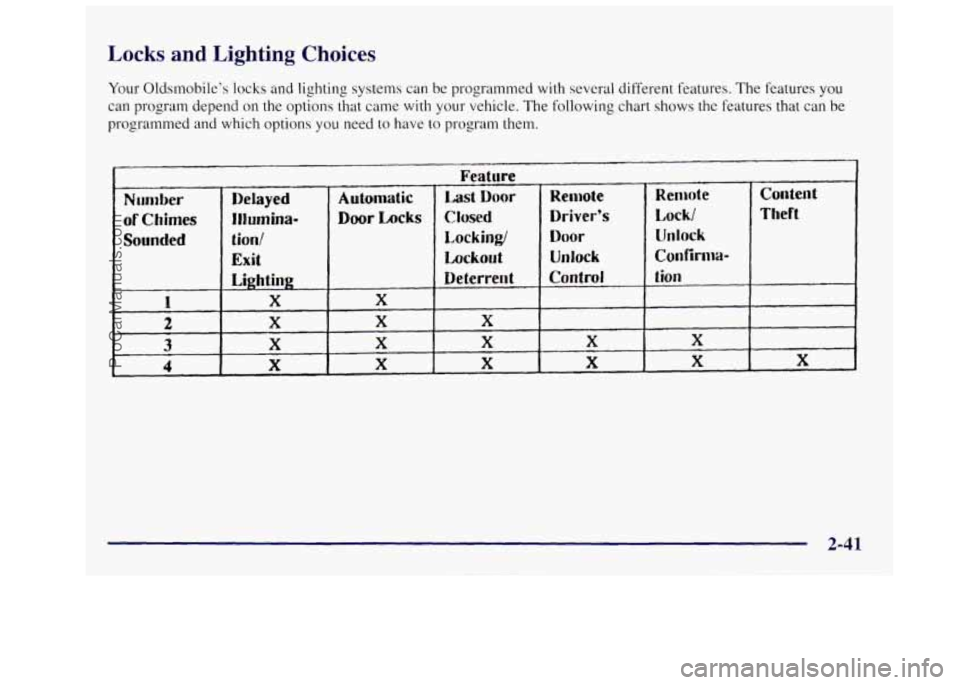
Locks and Lighting Choices
Your Oldsmobile’s locks and lighting systems can be programmed with several different features. The features you
can program depend on the options that came with your vehicle. The following chart shows the features that can be
programmed and which options you need to have to program them.
Number
of Chimes
Sounded
Feature
Delayed Automatic Last Door
Illumina- Door Locks Closed
tion/ Locking/
Exit Lockout
Lighting Deterrerl t
X X
X X X
X X X
X X X
Remote Remote Conterl t
Driver’s Lock/ Theft
Door Unlock
Unlock Confirm-
Contrd t ion
X X
X X X
2-41
ProCarManuals.com
Page 130 of 436
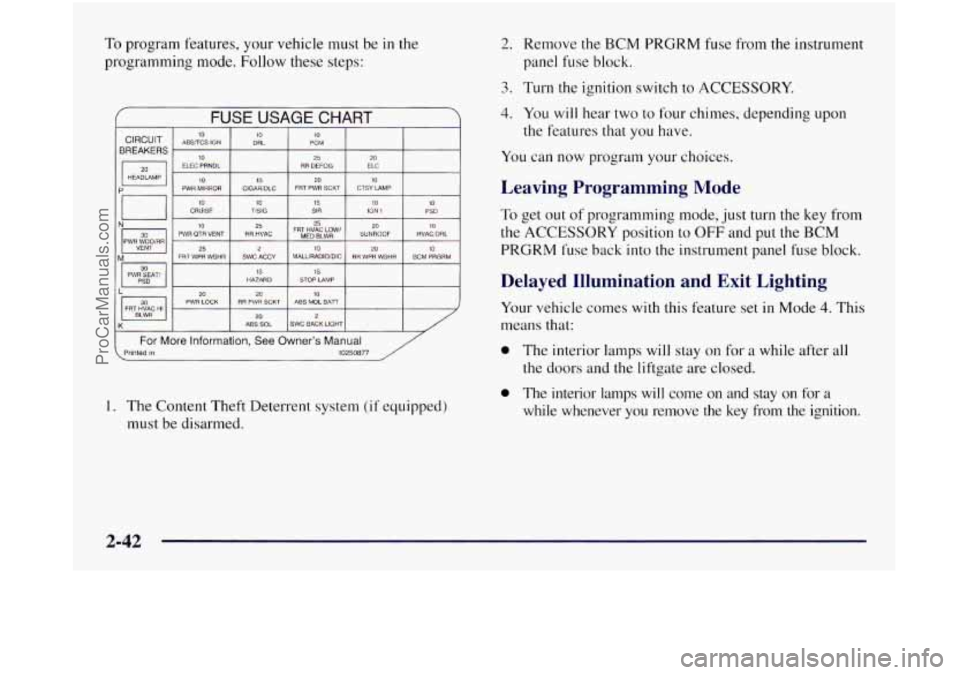
To program features, your vehicle must be in the
programming mode. Follow these steps:
f FUSE USAGE CHART
10 TISIG 15 SIR io IGN 1 10 PSD
I N- I PWH WTJOmR 30 111 PWR QTR VENT RR HVAC FRT MED HVAC BLWR Low’ SUNROOF HVACIDRL
VENT
25 20 M FRT WPR WSHR SWC ACCY MALLIRADIOIDIC RH WPR WSHR BCM PRGRM
PWR SEAT/ HAZARD
15 STOP LAMP
20 10 2u PWR LOCK ABS MDL BAi7 RR PWR SCKT FRT HVAC HI 20 2 ABS SOL SWC BACK LIGHT
( For More information, See Owner’s Manual Printed in 10250877
1. The Content Theft Deterrent system (if equipped)
must be disarmed.
2. Remove the BCM PRGRM fuse from the instrument
panel fuse block.
3. Turn the ignition switch to ACCESSORY.
4. You will hear two to four chimes, depending upon
the features that you have.
You can now program your choices.
Leaving Programming Mode
To get out of programming mode, just turn the key from
the ACCESSORY position to OFF and put the BCM
PRGRM fuse back into the instrument panel fuse block.
Delayed Illumination and Exit Lighting
Your vehicle comes with this feature set in Mode 4. This
means that:
0 The interior lamps will stay on for a while after all
the doors and the liftgate are closed.
0 The interior lamps will come on and stay on for a
while whenever you remove the key from the ignition.
2-42
ProCarManuals.com